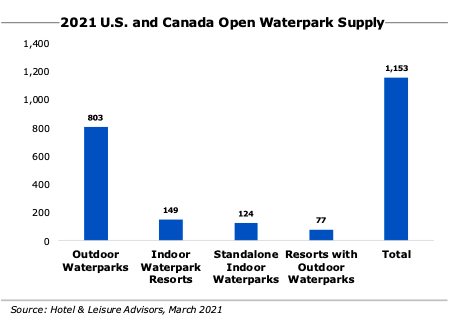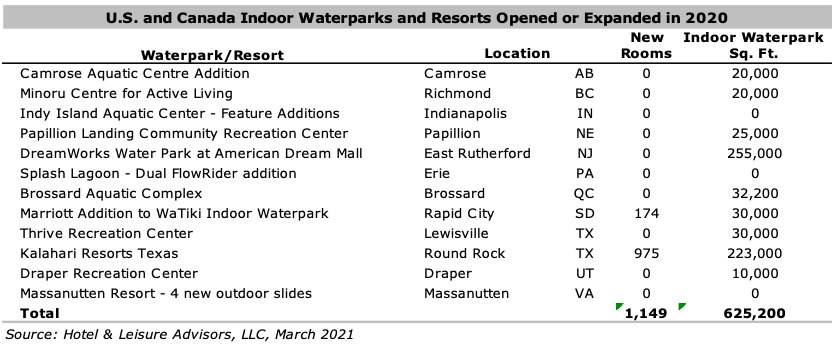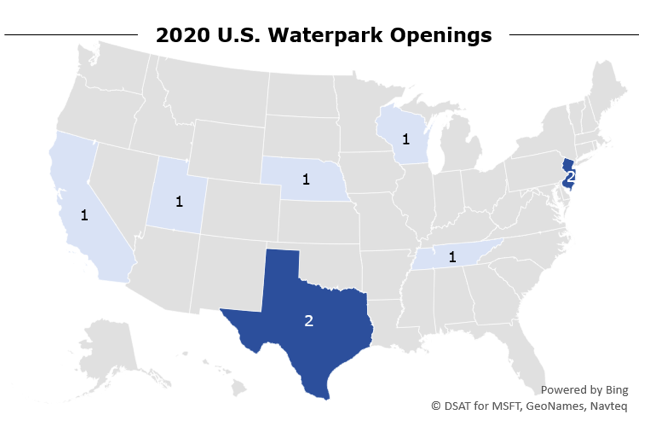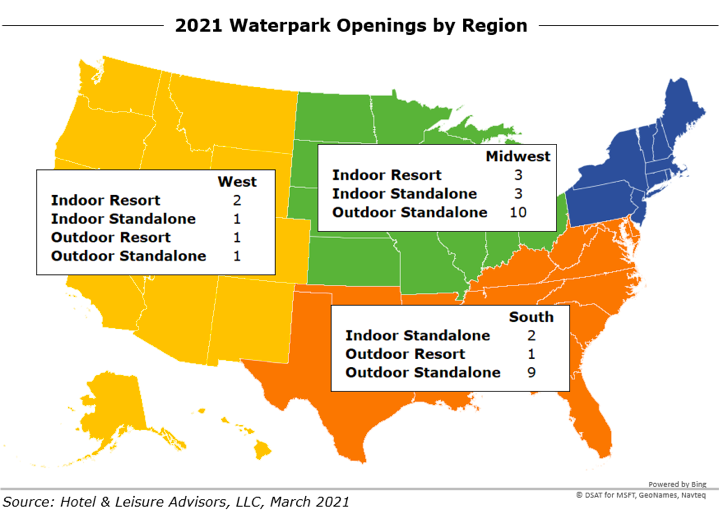By David J. Sangree
The COVID-19 crisis was the definitive event of 2020. The lodging and attractions industries were among the most negatively impacted sectors and experienced record declines in occupancy, attendance, and revenue. With mandated closures, limited capacities, and travel restrictions, many outdoor waterparks delayed their season openings while others decided, or were mandated, not to open at all in 2020. Many resorts with both indoor and outdoor waterparks and standalone indoor waterparks were forced to close for several months. Current projections for the vaccine rollout indicate a return to normalcy no earlier than the fall, making 2021 a year of continued depressed attendance and revenue.
Despite the challenges, more than half of the existing waterpark supply was able to open in some capacity in 2020. Many existing facilities took advantage of the closures to complete needed renovations. While many of the new outdoor facilities that were planned for 2020 were forced to postpone their openings until 2021; growth in the indoor segment in 2020 outpaced 2019.
Based on our research, the waterpark industry experienced a total attendance drop of about 83.9 million in 2020, leading to $3.7 billion in lost revenue. These numbers represent performance at a wide range of properties, including outdoor waterparks, resorts with outdoor waterparks, standalone indoor waterparks, and indoor waterpark resorts. All of these properties were sharply affected by the COVID-19 crisis in 2020 and will continue to face pandemic-related challenges throughout most of 2021.
CURRENT WATERPARK STANDINGS FOR THE U.S. AND CANADA
As of March 2021, the United States and Canada had a total of 1,153 waterparks. Twelve of those properties opened in 2020. More than half of these openings were in the indoor standalone segment, with one new private facility and six new municipal/non-profit facilities. One indoor waterpark resort and one outdoor waterpark resort opened in 2020. Three openings occurred in the standalone outdoor waterpark segment, two private and one municipal. The following bullets breakdown the numbers regionally:
- The Midwest and South are home to the most waterparks, with 408 and 381, respectively.
- The South maintains its lead over the Midwest in total number of outdoor waterparks with 294 versus 289, while Canada has the fewest at 33. Outdoor waterparks in the South typically have slightly longer operating seasons than those in the Northeast and Midwest due to more favorable weather conditions.
- The Midwest leads the U.S. and Canada in indoor waterpark resorts by a large margin with 85.
- The West leads in standalone indoor waterparks with 45, primarily due to the large number of municipal/non-profit indoor aquatic facilities with waterparks in Colorado and Utah.
- The South leads in resorts with outdoor waterparks with 47.
- Indoor waterparks account for a greater proportion of the Canadian market with 39 indoor resort and standalone facilities. Outdoor waterparks have held steady at 33.
- Of all hotels with indoor and outdoor waterparks, 44% are affiliated with national hotel franchises while 56% are independent properties.
- Of all standalone indoor and outdoor waterparks, 68% are municipal/non-profit while 32% are private/for-profit.
The following chart shows the breakdown of waterpark properties by type:
REVIEW OF 2020 NEW OPENINGS AND EXPANSIONS
Indoor Waterpark Openings: In 2020, twelve indoor waterpark additions or expansions added 625,200 square feet of indoor waterpark space compared to 335,500 square feet in 2019.
The number of new resort rooms in 2020 showed gains over 2019 with a supply increase of 1,149. The two most significant project openings were:
- The Kalahari Resort in Round Rock, Texas, is the brand’s fourth resort. The facility offers 975 rooms; a 223,000-square-foot indoor waterpark; the 80,000-square-foot Tom Foolery’s Adventure Park (indoor FEC) with thrill rides, ropes course, climbing walls, zip line, bowling, laser tag, mini-golf and more; a spa and salon; an arcade with 250+ games; 10,000 square feet of retail space; a 200,000-square-foot convention center; five full-service restaurants; and a two-acre outdoor waterpark that includes multiple pools and attractions.
- The 255,000-square-foot DreamWorks Water Park at American Dream Mall in East Rutherford, New Jersey, opened in 2020 after missing its original 2019 projected opening date. It occupies six stories adjacent to Nickelodeon Universe American Dream. The indoor waterpark is part of the entertainment mall, which also includes an indoor ski slope, an indoor ice rink, and a variety of stores and attractions. There are 40 water slides and 15 attractions themed toward specific DreamWorks franchises. The property offers a 56,000-square-foot indoor wave pool, the largest indoor wave pool in North America. It does not currently have a connected hotel, but the developers plan to build a hotel attached to the mall as part of a future expansion.
Outdoor Waterpark Openings: Due to the COVID-19 pandemic, many waterparks that were scheduled to open in 2020 were postponed until 2021. Consequently, only three new standalone outdoor waterparks opened in 2020.
The most significant new addition was the $90 million Soaky Mountain Waterpark in Sevierville, Tennessee, by Wilderness Resorts and Waterparks. The 50-acre park features multiple slides, a wave river, a children’s area, a double FlowRider, raft rides, and water coaster.
Resorts with Outdoor Waterparks Openings: With only two openings or expansions, resorts with outdoor waterparks had the smallest number of additions in 2020.
All Openings: The following map highlights the locations of the 2020 indoor and outdoor waterpark openings in the U.S. inclusive of resorts and standalone properties.
COVID-19 IMPACT
With the largest database of waterparks and waterpark resorts across North America, H&LA tracks the openings and closings of standalone waterparks and resorts with waterparks. We analyzed waterparks by type (outdoor versus indoor, resorts versus standalone) and grouped them by size and operating status (open versus closed). We estimated 2020 attendance and per capita spending for each group based on our waterpark financial and attendance database, interviews with various parks, industry publications, SEC filings, and other industry sources. We also considered whether the waterparks are private or municipally owned. We then estimated the impact from COVID-19 for each of the groups based on the number of days open and potential impact from reduced demand and limited capacity. For resort properties with waterparks, our analysis focused on leisure guests that utilize the waterpark and did not estimate impact on the resort from lost group and commercial guests.
Outdoor Waterparks: For most outdoor waterparks, the season typically begins around Memorial Day and ends between mid-August and Labor Day. For resorts with outdoor waterparks, although the resorts are open year-round, their waterparks may be seasonal, except in Florida, where some of the waterparks are open year-round. As the 2020 waterpark season kicked off, the vast majority of waterparks decided to delay opening or were mandated not to open, while some decided to remain closed for the entire 2020 season. In June 2020, one month into the waterpark season, 70% of outdoor waterparks remained closed with a sizable number of municipal waterparks deciding to close for all of 2020. As of mid-August, towards the end of the waterpark season, 43% of the outdoor waterparks in the United States had not opened for most or all of the 2020 season. A number of waterparks that opened in June had to close again due to government mandates.
Indoor Waterpark Resorts and Standalone Indoor Waterparks: Unlike most outdoor waterparks, indoor waterpark resorts and standalone indoor waterparks are open on a year-round basis. However, due to travel restrictions and government mandates, many indoor waterparks were forced to close in March and April 2020. By the end of May, approximately 80% of the indoor waterparks in the United States remained closed. As travel restrictions started lifting, indoor waterparks (resorts and standalone) opened with limited capacity. Some indoor waterpark resorts remained open for lodging, but their waterparks were closed. For our analysis, we considered these properties as closed. By the end of June, as restrictions eased further, approximately 36% of the indoor waterparks (resorts and standalone) remained closed. Our research indicates that as of mid-August 2020, 18% of the indoor waterparks in the United States remained closed.
H&LA estimates an overall impact of the COVID-19 pandemic of $3.7 billion in lost revenue and 83.9 million in lost attendance for all outdoor waterparks, resorts with outdoor waterparks, standalone indoor waterparks, and indoor waterpark resorts in the United States in 2020. Standalone indoor and outdoor waterparks account for $1.4 billion in lost revenue and 61.2 million in lost attendance, while resorts with an indoor or outdoor waterparks account for $2.3 billion in lost revenue and 22.7 million in lost attendance. Attendance was down 62% from 2019 at U.S. waterparks due to the closures and mandates associated with COVID-19.
PROJECTIONS FOR 2021
For 2021, we will see growth across all segments of the waterpark industry with projected openings of 34 facilities. We also anticipate expansions of more than 31 existing facilities. Regionally, the Midwest leads the U.S. with 16 projected openings, driven by Illinois, Missouri, and Ohio. The South will see 12 openings, the West five, and Canada one. As of this writing, no major openings or expansions are anticipated for the Northeast. The following map highlights the locations of the properties.
Indoor Waterparks: With projections of 403,000 square feet of new indoor waterpark space and nearly 771 new rooms, 2021 will be a year of continued growth in this market segment. A large indoor waterpark resort will open in California along with smaller additions to properties in Kansas and Michigan. There are also a number of municipalities adding standalone indoor waterparks as parts of their recreation centers. The following are highlights of the larger projects.
- After a postponement from 2020, Great Wolf Resorts will open its new Manteca, California resort, which will offer 500 rooms and a 95,000-square-foot waterpark. The $220 million resort will also feature a 45,000-square-foot adventure park that will include ropes courses, an arcade, mini-golf, and a live-action adventure game.
- The Island Resort and Casino in Harris, Michigan is adding a 25,000-square-foot indoor waterpark, 138 additional hotel rooms, restaurant, and additional conference space to their casino resort property. The $30 million expansion will increase the hotel size to 455 rooms.
Outdoor Waterparks: Growth in the outdoor segment will continue with 21 new standalone waterparks and two resorts with outdoor waterparks anticipated. Larger outdoor waterpark developments in 2021 include the following:
- Baha Mar Resort in Nassau, Bahamas is adding the $200 million Baha Bay outdoor waterpark adjacent to the SLS and Melia Hotels. The well themed waterpark is due to open in July 2021 and will include a wide range of rides and attractions. It will be one of the most expensive waterparks to open in North America.
- Westgate Lakes Resort & Spa in Orlando, Florida, is building a waterpark at the current site of the Pelican’s Landing Pool. The waterpark will include waterslides, a lazy river, and a children’s water play area.
- Further demonstrating a trend towards more extensive amenities at municipal waterparks, the City of El Paso, Texas, will unveil four new themed waterparks featuring slides, lazy rivers, climbing walls, and cabanas. One waterpark will include a surf machine.
Surf Innovations: New innovations continue to be developed for the waterpark industry including multiple new man-made surfing facilities by companies including Surf Lakes, American Wave Machines, SurfLoch, Whitewater, and others. We expect to see additional opportunities for consumers to enjoy surfing on artificial waves in the coming years as developers work to construct multiple projects.
CONCLUSION
The waterpark industry was negatively affected by the COVID-19 pandemic at an unprecedented level in 2020 with an attendance drop of 62% for the entire industry. The substantial revenue loss will be a setback for the industry for years to come as owners and investors of waterpark projects work to sustain their properties amid those losses. 2021 should see a definite improvement in terms of attendance and revenues over 2020, but we do not forecast a return to pre-pandemic levels as the vaccine rollout is not expected to be available to all Americans until the fall of 2021. However, the waterpark industry is dynamic and resilient. Though the road to recovery will not be easy, operators are refocusing their marketing and operational strategies to adjust to the new normal going forward, setting the industry up for a robust recovery.
2021 will bring the opening of a number of new standalone waterparks and resorts with waterparks, including a major new Great Wolf Lodge project in Manteca, California and the new Baha Bay waterpark at Baha Mar Resort in the Bahamas. Developers and consumers continue to be interested in new waterpark developments, and we expect to see a continued pipeline of new projects in the coming years.








